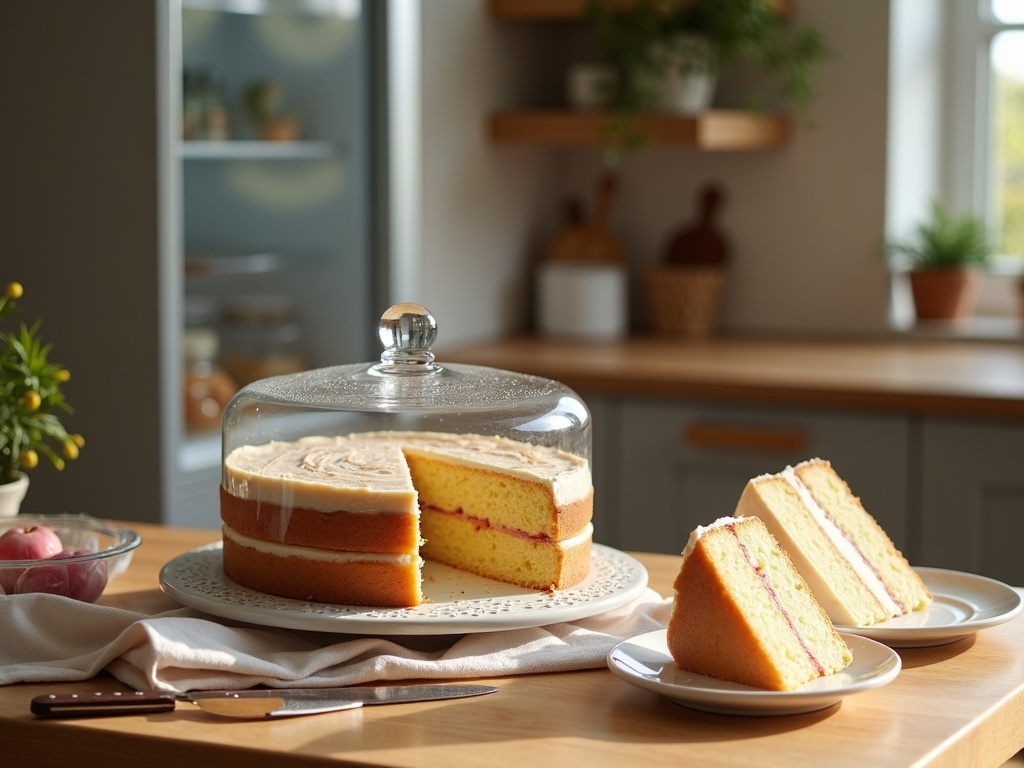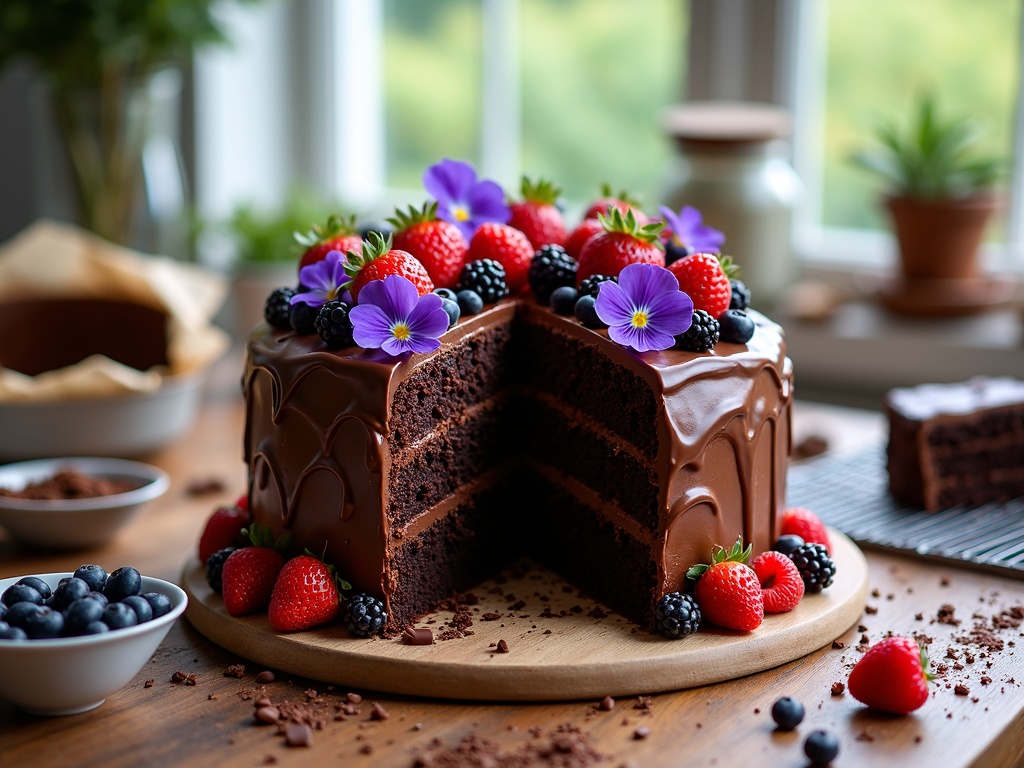This delightful vegan cake recipe rivals traditional baked goods with its exceptional moisture and rich flavor, all while using only plant-based ingredients that accommodate various dietary needs.
Find In This Article
Key Takeaways
- The cake achieves its moist texture through a careful balance of ingredients including vegetable oil and the chemical reaction between baking soda and apple cider vinegar.
- Room temperature ingredients are crucial for proper mixing, with overmixing being a common mistake that results in dense, tough texture.
- The recipe uses simple pantry staples rather than expensive specialty items, making it accessible for last-minute baking.
- Proper cooling is essential before frosting, with vegan cakes needing to cool completely to prevent melting and sliding frosting.
- Numerous decorating options exist, from fresh berries and edible flowers to chocolate shavings and nuts, allowing for customization to any occasion.
Why This Vegan Cake Recipe Will Impress Everyone
I’ve brought this vegan cake to countless birthday parties, holiday gatherings, and weekend get-togethers, and it never fails to amaze guests. The look of surprise when I mention it contains no eggs or dairy is always priceless. This cake manages to be exceptionally moist and rich while using only plant-based ingredients, making it perfect for anyone with dietary restrictions or those simply looking to reduce their animal product consumption.
Perfect for Any Celebration
This cake stands tall as a centerpiece for special occasions but is simple enough to whip up when you’re craving something sweet on a lazy Sunday afternoon. The versatility of this recipe means you can:
- Dress it up with fancy decorations for birthdays and weddings
- Keep it simple for casual family dinners
- Adjust the flavors seasonally (think warming spices in fall or fresh berries in summer)
- Make it in advance for stress-free entertaining
You don’t need to be a professional baker to create something spectacular. This cake aligns perfectly with other favorite vegan desserts that have become staples in my kitchen.
Rich Flavor Without Animal Products
The magic of this recipe lies in how it achieves the same depth of flavor and tender crumb you’d expect from traditional cakes. I’ve tested dozens of combinations to perfect this recipe, and the results speak for themselves. The cake remains moist for days (though it rarely lasts that long in my house!).
For chocolate lovers, this cake rivals even the most indulgent Black Forest gateau without compromising on taste. And if fruit-forward desserts are more your style, the base recipe adapts beautifully to complement fresh seasonal ingredients like those found in a classic strawberry shortcake recipe or a warming rhubarb crumble.
What truly sets this cake apart is how it maintains that perfect balance between lightness and richness that’s often lost in vegan baking. The crumb structure closely resembles that of a traditional plum cake but without any eggs or butter.
The straightforward ingredient list consists of pantry staples you likely already have on hand. No hunting for obscure substitutes or expensive specialty items means you can satisfy your cake craving whenever it strikes. I’ve found this accessibility particularly helpful when preparing last-minute desserts, much like my go-to peach crisp recipe that never disappoints.
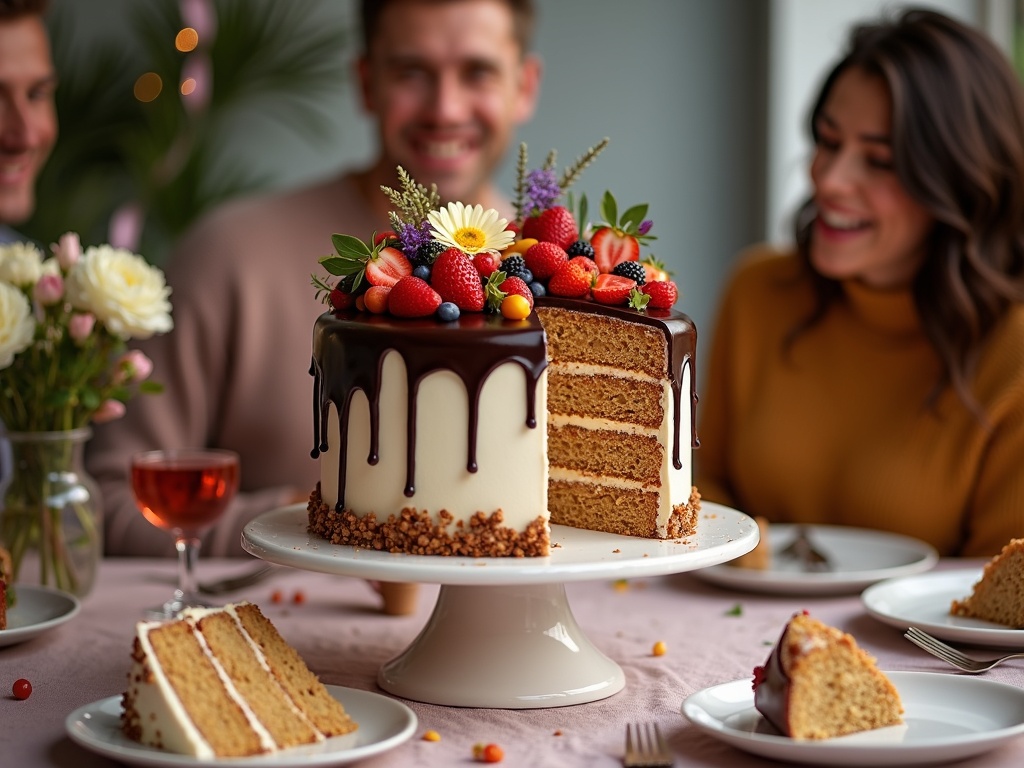
Ingredients You Will Need
The foundation of any successful vegan cake starts with the right ingredients. I’ve carefully selected components that work together to create a moist, flavorful cake without using any animal products. The beauty of this recipe lies in its simplicity – you’ll find most of these items already in your pantry.
Essential Components for Your Vegan Cake
For the dry ingredients, you’ll need:
- All-purpose flour: Provides the structure for your cake
- Granulated sugar: Adds sweetness and helps with moisture retention
- Unsweetened cocoa powder: Gives that rich chocolate flavor we all crave in delicious vegan desserts
- Baking soda: Acts as the leavening agent to help your cake rise
- Salt: Just a pinch enhances all the flavors
The wet ingredients bring everything together:
- Vanilla extract: Adds depth and warmth to the flavor profile
- Vegetable oil: Creates moisture and tenderness in the cake
- Apple cider vinegar: Reacts with the baking soda to create lift
- Plant-based milk: Almond or soy milk works perfectly as a dairy alternative
- Hot water: Helps bloom the cocoa powder and creates a lighter texture
The combination of baking soda and apple cider vinegar is particularly important in vegan baking. This dynamic duo creates the chemical reaction needed for the cake to rise properly without eggs. The result is a tender cake texture that rivals traditional recipes.
I’ve found that using hot water helps intensify the chocolate flavor by blooming the cocoa powder effectively. This technique is used in many classic chocolate cake recipes and works perfectly in this vegan version.
For the plant-based milk, both almond and soy work wonderfully, but feel free to use your favorite variety. Oat milk can create an especially creamy result, while coconut milk adds a subtle tropical note that pairs beautifully with the chocolate.
The vegetable oil keeps your cake moist for days, unlike butter-based cakes that can dry out quickly. This makes it perfect for preparing ahead for special occasions or when you want to enjoy homemade treats throughout the week.
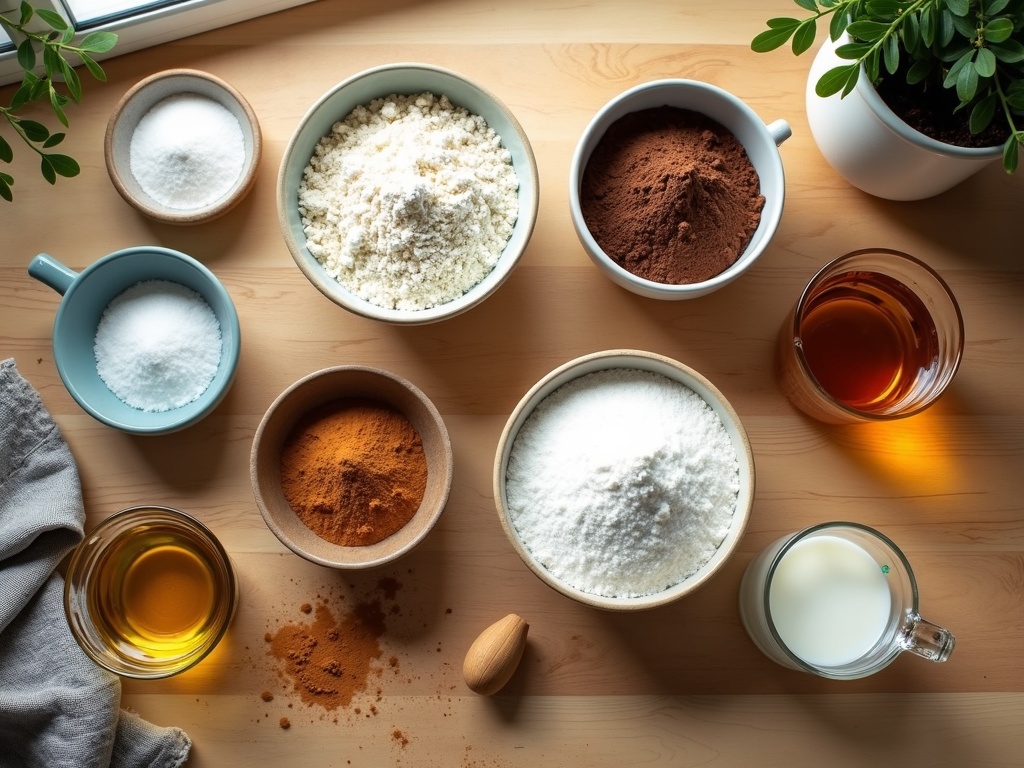
Step-by-Step Baking Instructions
I’m going to walk you through the process of creating a perfect vegan cake from start to finish. These instructions ensure consistent results even if you’re new to vegan baking.
Preparation and Mixing
First, preheat your oven to 350°F (175°C). This temperature creates the ideal environment for your cake to rise evenly without burning the edges. While the oven heats up, gather all your ingredients so they’re ready to go.
In a large bowl, thoroughly mix all your dry ingredients. This typically includes:
- Flour
- Sugar
- Baking powder
- Baking soda
- Salt
- Any spices your recipe calls for
Whisking these ingredients together ensures even distribution of leavening agents, which prevents unpleasant pockets of baking powder in your finished cake.
In a separate bowl, combine your wet ingredients. For vegan cakes, this usually involves:
- Plant milk
- Oil
- Vanilla extract
- Vinegar or lemon juice (to activate baking soda)
Some vegan desserts might also include applesauce or mashed banana as egg replacers.
Now comes a crucial step: fold the wet ingredients into the dry mixture using gentle, sweeping motions. Overmixing can develop gluten, resulting in a tough, dense cake texture rather than the light, fluffy consistency you’re after. Mix just until no dry spots remain.
Baking and Cooling
Pour the batter into your prepared cake pan. I recommend lining the bottom with parchment paper and lightly greasing the sides for easy removal. Give the pan a gentle tap on the counter to release any large air bubbles trapped in the batter.
Place the pan in the middle rack of your preheated oven and bake for 30–35 minutes. The exact time may vary depending on your oven, so start checking at the 25-minute mark. The cake is done when a toothpick inserted in the center comes out clean or with just a few crumbs attached.
Allow the cake to cool in the pan for about 10 minutes. This initial cooling helps the structure set properly. Then, carefully transfer it to a wire rack to cool completely before frosting. Attempting to frost a warm cake will cause the frosting to melt and slide off.
For an extra special treat, consider making a strawberry-based frosting or a fruit compote topping to complement your vegan cake. The natural sweetness of fruits pairs beautifully with the subtle flavors of the cake.
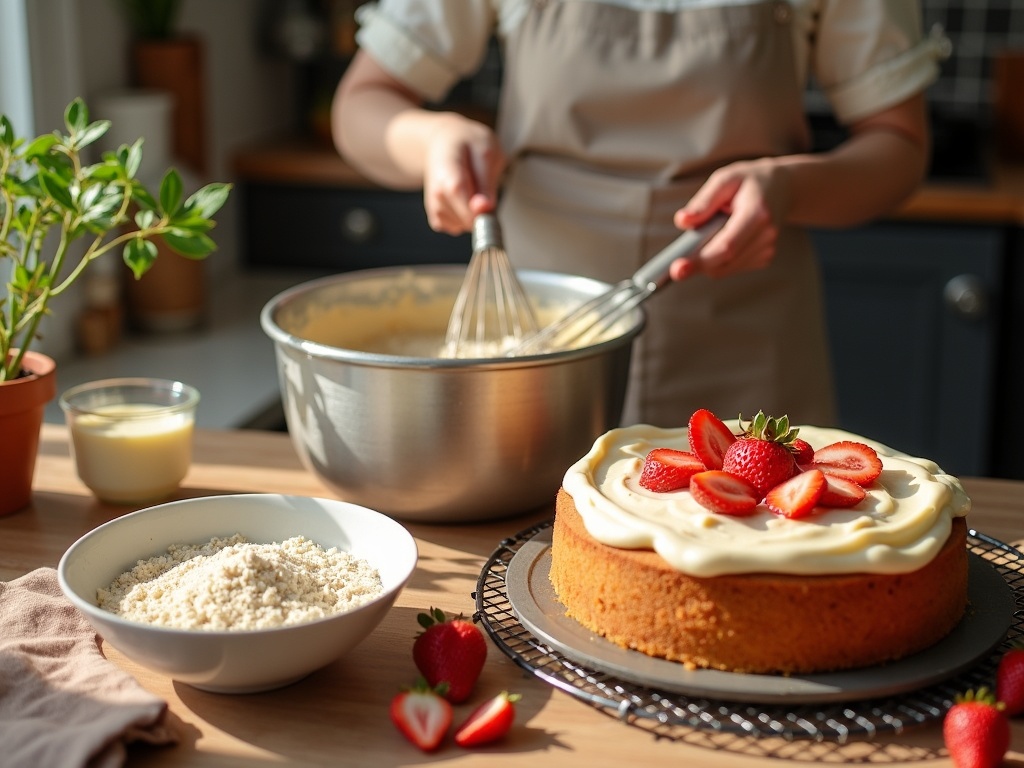
Common Mistakes to Avoid
I’ve baked my fair share of vegan cakes, and I’ve learned that even small mistakes can impact the final result. Creating a perfect vegan cake isn’t just about having the right ingredients – it’s about technique and attention to detail during the process.
Technical Pitfalls in Vegan Baking
Overmixing the batter is perhaps the most frequent error I see new vegan bakers make. When you mix flour with wet ingredients, gluten begins to develop. Too much mixing creates a dense, tough vegan dessert rather than the light, fluffy texture you’re aiming for. I always mix just until the ingredients are combined, then stop.
Opening the oven door while baking disrupts the cooking process significantly. Each time you peek, the temperature can drop by 25–50 degrees, leading to uneven rising or a collapsed center in your plant-based cake. I resist the urge to check and trust my timer instead.
Not letting your cake cool completely before frosting is a mistake I made often as a beginner. Hot or warm cakes will cause frosting to melt and slide right off. For best results, I let my vegan cake layers cool in the pan for 10 minutes, then transfer to a wire rack until completely cool.
Using cold ingredients in your vegan cake batter can result in uneven mixing and poor texture. Cold plant milk or refrigerated applesauce (common egg replacers) can cause coconut oil to solidify in chunks. I always bring refrigerated ingredients to room temperature before starting.
Incorrect pan size might seem minor, but it dramatically affects baking time and texture. Using a pan too large spreads the batter thin, resulting in overbaking, while a pan too small might cause the vegan batter to overflow or remain undercooked in the center. I measure my pans across the top from inside edge to inside edge for accuracy.
Key Points to Remember for Vegan Cake Success:
- Mix until just combined – a few small lumps are preferable to overmixing
- Set a timer and resist opening the oven for the first 75% of baking time
- Allow at least 2 hours of cooling time before frosting
- Measure ingredients precisely, especially leavening agents like baking powder
- Test for doneness with a toothpick in the center rather than relying solely on time
My most successful vegan baked treats come from learning from these mistakes. With practice and attention to these details, you’ll be creating perfect plant-based cakes that everyone will enjoy.
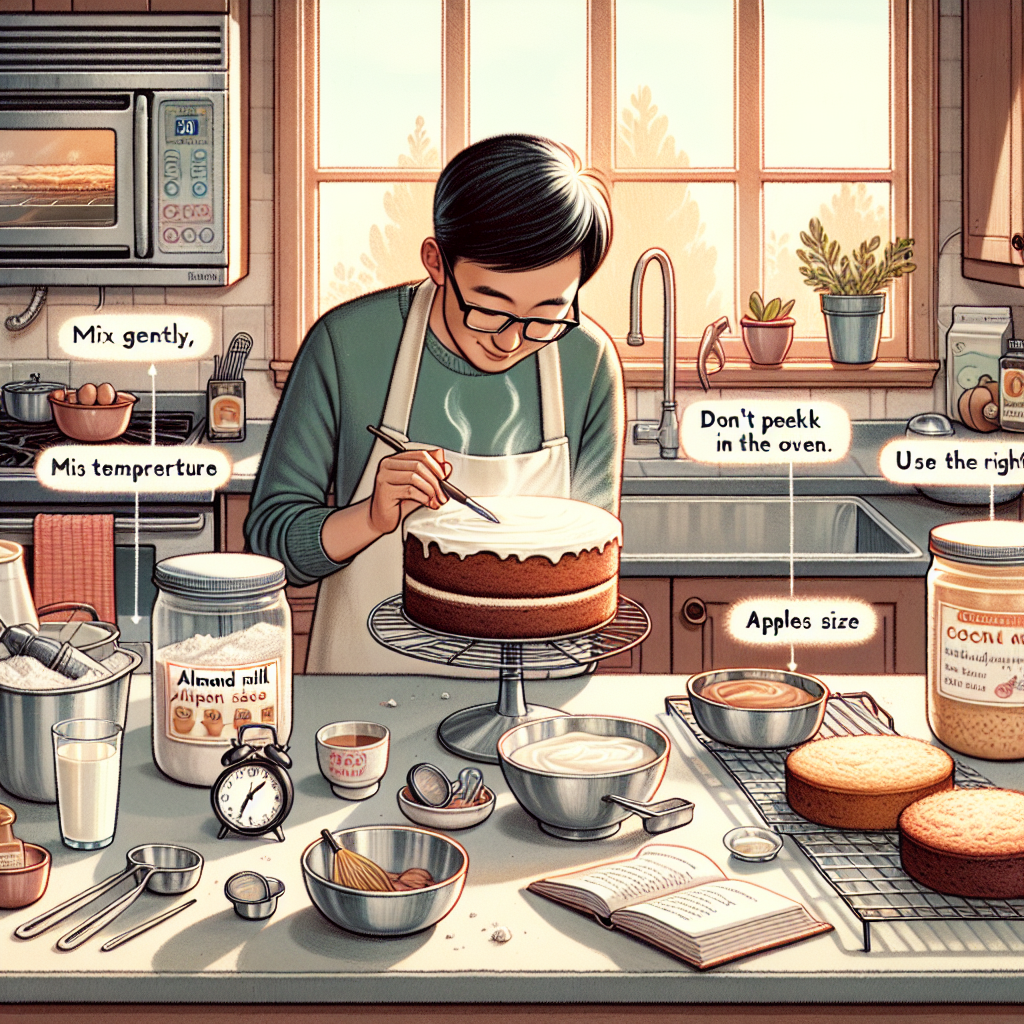
Pro Tips for Perfect Results
Preparing a stellar vegan cake doesn’t have to be complicated. I’ve gathered some key techniques that make a real difference in achieving bakery-quality results at home.
Essential Preparation and Baking Techniques
Always bring all ingredients to room temperature before starting. Cold ingredients don’t incorporate well, resulting in uneven textures. I typically set out my plant milk, applesauce (or other egg replacers), and vegan butter about 30-60 minutes before mixing.
Using parchment paper in your cake pan is non-negotiable for vegan cakes. These cakes can be more delicate than traditional ones, so this extra step prevents sticking and crumbling when removing from the pan. I cut a circle for the bottom and strips for the sides, which has saved countless homemade desserts from disaster.
The toothpick test remains the gold standard for checking doneness in vegan cakes. Insert a toothpick into the center – it should come out clean or with just a few moist crumbs. If it’s still wet with batter, give it another 3-5 minutes before checking again.
For storing your masterpiece, an airtight container at room temperature works perfectly for 3-4 days. This keeps the moisture locked in and prevents the cake texture from drying out too quickly – a common issue with vegan baked goods.
I’ve found freezing unfrosted cake layers to be a game-changer. They can last up to 3 months when wrapped properly in plastic wrap and foil. This approach lets you prepare components ahead for special occasions like creating a stunning vegan gateau or elaborate strawberry-topped dessert.
For fruit-based vegan cakes, don’t overmix once the flour is added. Just combine until no dry spots remain to keep the texture light. This technique works especially well when making fruit-forward recipes like rhubarb desserts or a summery peach-based treat.
When substituting ingredients, maintain the same ratios – especially for leavening agents. Vegan cakes rely heavily on the perfect chemical reaction between baking soda, powder, and acidic ingredients like apple cider vinegar or lemon juice.
Lastly, don’t open the oven door during the first 25 minutes of baking. The rush of cold air can cause your cake to sink in the middle, undoing all your careful preparation work.
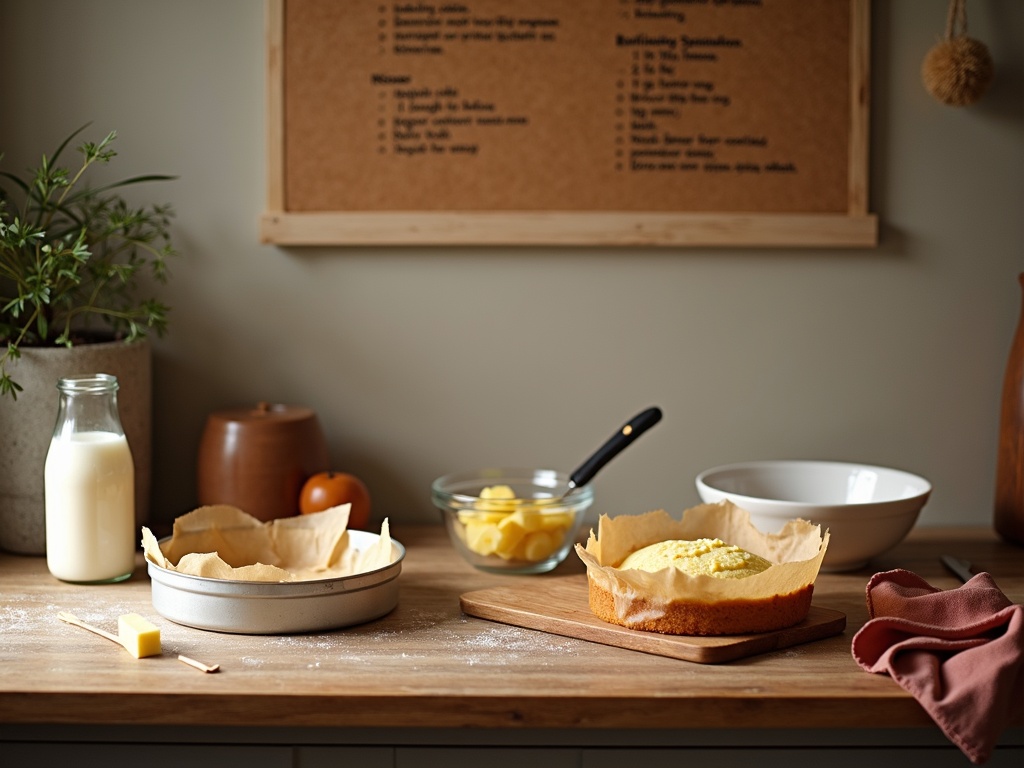
Vegan Frosting Options
The perfect vegan cake deserves the perfect finishing touch! I’ve experimented with numerous dairy-free frosting recipes over the years and found several options that rival (or even surpass) their traditional counterparts. These vegan frosting alternatives provide that essential sweet, creamy touch to delicious plant-based desserts without compromising on taste or texture.
Smooth and Creamy Plant-Based Toppings
Chocolate ganache is perhaps the simplest yet most decadent vegan frosting option. By combining melted dark chocolate with heated coconut cream, you’ll create a glossy, rich topping that sets beautifully on cakes. It’s particularly stunning on a vegan black forest gateau, where the intense chocolate complements the cherries perfectly.
Vanilla buttercream remains a classic for good reason. Whip together vegan butter (make sure it’s at room temperature), powdered sugar, vanilla extract, and a splash of plant milk until fluffy. This versatile frosting pairs wonderfully with almost any fruit-based cake recipe and can be colored with natural food dyes for special occasions.
Berry cream offers a fruity alternative that brightens up any dessert. Blend soaked cashews with maple syrup, coconut oil, lemon juice, and fresh berries for a naturally colored and flavored frosting. This vibrant topping is especially beautiful on a homemade strawberry shortcake or summer fruit cakes.
Coconut whipped cream provides that light, airy texture that’s perfect for layering between cake tiers or topping a tangy fruit dessert. Simply chill a can of full-fat coconut milk overnight, scoop out the solidified cream, and whip with powdered sugar and vanilla until peaks form.
Classic glaze delivers that shiny, sweet coating that’s ideal for bundt cakes or fruit-topped desserts. Mix powdered sugar with a small amount of plant milk and vanilla extract until you achieve your desired consistency. This quick frosting option dries to a beautiful finish and doesn’t require refrigeration.
Each of these vegan frosting options can be customized with different flavorings, from citrus zest to spices or extracts. The key to success lies in allowing your cake to cool completely before applying any frosting, which prevents melting and ensures a flawless presentation.
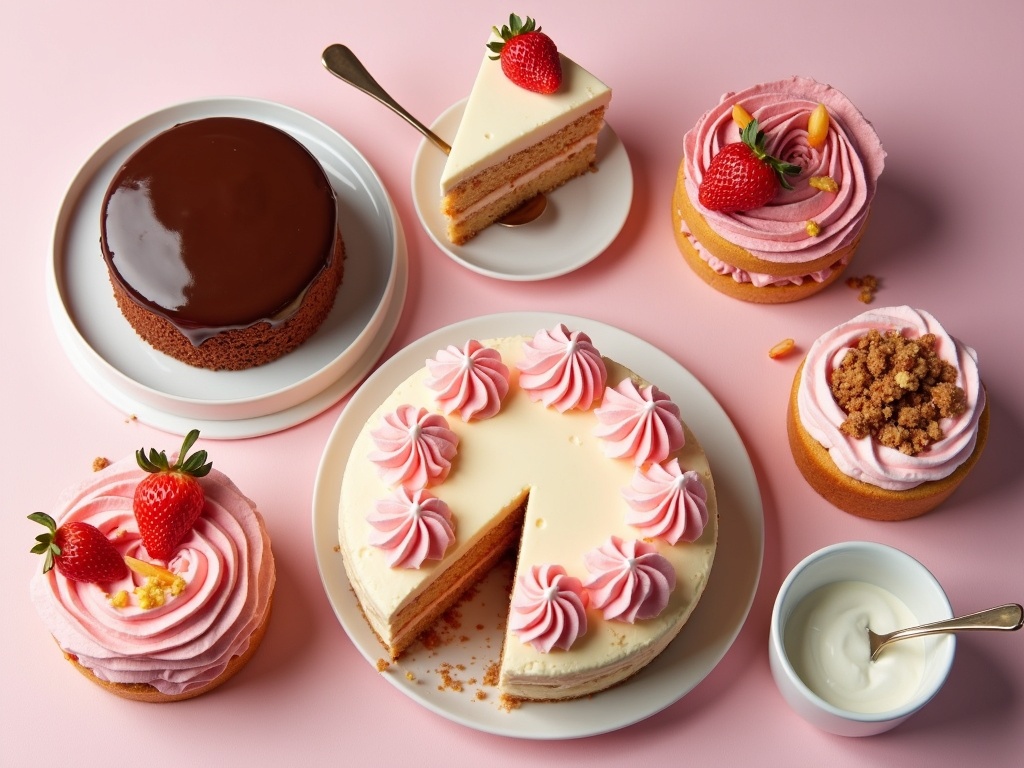
Decorating Ideas
The beauty of vegan cakes lies not just in their taste but also in their presentation. I’ve found that with the right decorations, a simple vegan cake can transform into a stunning centerpiece for any occasion. Whether you’re making a fruit-based cake or a chocolate delight, these decoration ideas will elevate your creation.
Natural and Colorful Toppings
Fresh berries offer both vibrant color and a burst of natural sweetness to vegan cakes. I like to arrange strawberries, blueberries, raspberries, or blackberries in patterns atop frosted cakes for an elegant finish. They pair particularly well with vanilla or lemon-flavored cakes, creating a refreshing contrast. For a stunning summer treat, try adding these to a strawberry shortcake recipe or a citrus-infused cake.
Edible flowers bring a touch of sophistication to any vegan cake. Violets, pansies, nasturtiums, and rose petals are all edible options that can create a garden-inspired look. Just make sure they’re organic and haven’t been treated with chemicals. I often place these delicate blooms around the edges of my cakes or scattered across the top for special occasions. They’re especially striking on fruity desserts like rhubarb or berry cakes.
Chocolate shavings add texture and depth to vegan cakes. Using a vegetable peeler, I create delicate curls from dairy-free dark chocolate bars to sprinkle over frosted surfaces. For an extra touch, try dusting them with a little cocoa powder or powdered sugar. These work wonderfully on rich chocolate cakes or coffee-flavored desserts.
Sprinkles aren’t just for kids’ parties! I’ve found many brands now offer vegan-friendly sprinkles in various shapes and colors. Check the ingredients to ensure they don’t contain confectioner’s glaze (which often contains shellac). A light scattering of colorful sprinkles can turn a simple cake into a celebration cake in seconds. They’re perfect for birthdays or whenever you need a mood lift.
Nuts or coconut flakes provide both flavor and visual appeal. Toasted almond slices, crushed pistachios, or lightly toasted coconut flakes can be pressed into the sides of frosted cakes or sprinkled on top. I particularly enjoy using these on fruit-based desserts like peach or apple cakes. The contrast between the soft cake and crunchy nuts creates a delightful textural experience.
When decorating vegan cakes, I find it helpful to consider complementary flavors. For instance, mint leaves pair beautifully with chocolate, while citrus zest works well with berry cakes. Don’t be afraid to mix and match these decoration ideas based on your flavor profile. A sprinkling of edible flowers alongside fresh berries can create a stunning spring-themed cake.
For those new to cake decorating, start simple:
- A modest dusting of cocoa powder through a paper stencil
- A few slices of fresh fruit
- A single flower or herb sprig as a garnish
As you gain confidence, you can experiment with more intricate patterns and combinations of decorative elements.
Remember that the goal of decorating is to enhance your vegan cake, not overwhelm it. Sometimes less is more – a few strategically placed berries or a light dusting of coconut can be just as effective as elaborate designs. The key is to complement the flavors of your homemade dessert while creating visual appeal.
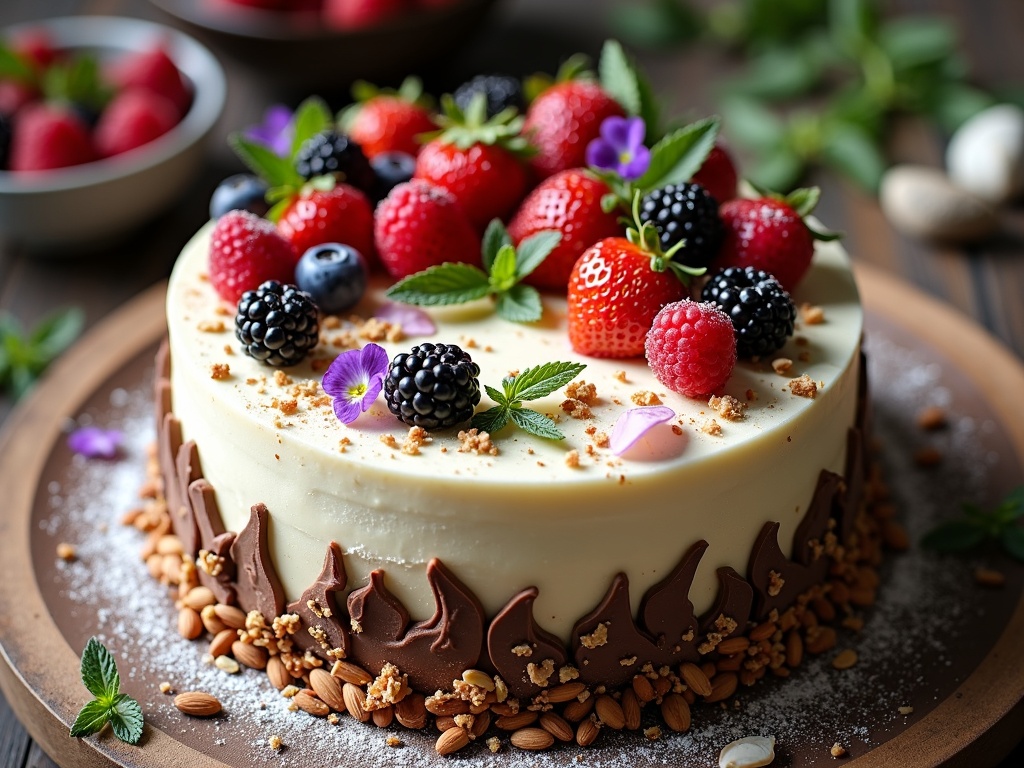
Storing and Serving
I’ve learned through plenty of trial and error that proper storage makes all the difference in maintaining the perfect texture and flavor of vegan cakes. While traditional cakes often rely on dairy ingredients for moisture retention, vegan cakes require specific storage methods to stay fresh and delicious.
Storage Options for Your Vegan Cake
When you’ve spent time creating a beautiful vegan dessert, the last thing you want is for it to dry out or lose flavor prematurely. For short-term storage, room temperature works beautifully. Simply place your cake in an airtight container or cover it tightly with plastic wrap, and it’ll stay fresh for up to 3 days on your counter. This method preserves that just-baked softness that makes homemade cakes so special.
For longer storage, the refrigerator offers extended freshness. Your vegan cake will remain tasty for up to a week when properly refrigerated. The key here is protecting it from absorbing other flavors in your fridge:
- Double-wrap with plastic wrap, or
- Use a cake keeper with a good seal
Remember that refrigeration can sometimes firm up plant-based ingredients more than conventional ones. That’s why I always recommend letting refrigerated vegan cake slices sit at room temperature for about 20–30 minutes before serving. This quick step restores that perfect crumb texture that might otherwise seem a bit dense when cold.
Serving Tips for the Perfect Slice
Temperature matters tremendously when serving vegan cakes. Even the most magnificent plum cake or black forest gateau won’t shine at its best when served cold. Room temperature brings out the full flavor profile and allows the cake’s texture to reach its peak softness.
One professional trick I’ve adopted is using a hot knife for slicing. This simple technique makes a noticeable difference in presentation, especially with layer cakes or those with delicate fillings like strawberry shortcake:
- Run your knife under hot water,
- Quickly wipe it dry, and
- Cut the cake for smooth, clean slices
For frosted vegan cakes, I’ve found that a slight chill (about 15–20 minutes in the refrigerator) before cutting helps the frosting stay in place, while still keeping the cake itself at a nice serving temperature. This is particularly useful for summer gatherings where a peach dessert or other seasonal treat might otherwise melt in the heat.
Don’t forget about adapting your storage approach based on the specific ingredients in your cake. Fruit-filled vegan cakes like rhubarb desserts generally benefit from refrigeration even for short-term storage, while simple chocolate or vanilla cakes do just fine at room temperature.
With these straightforward storage and serving practices, you’ll ensure every slice of your vegan cake delivers the perfect combination of flavor and texture — from the first piece to the last.
